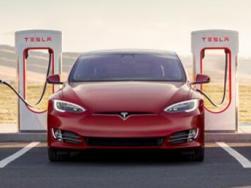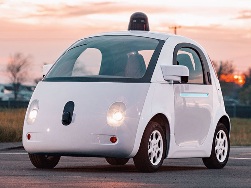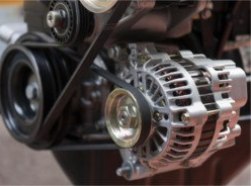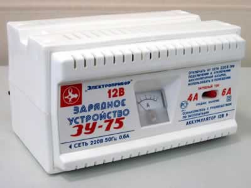Tesla Supercharger Power Supplies
 The Tesla Supercharger network is a 480-volt DC charging station system designed to quickly charge electric car batteries made by Tesla Inc. All machine models, including Tesla Model S, Model 3 and Model X, can quickly restore the life of their traction batteries, thanks to these fast charging stations.
The Tesla Supercharger network is a 480-volt DC charging station system designed to quickly charge electric car batteries made by Tesla Inc. All machine models, including Tesla Model S, Model 3 and Model X, can quickly restore the life of their traction batteries, thanks to these fast charging stations.
The network began to be built in 2012, and as of the first half of 2018, there were already about 10,000 chargers in about 1250 stations in the world. The very idea of the ubiquitous introduction of Tesla Supercharger charging stations was born in the company after their very first idea was not asked - “quick battery change”, which turned out to be unclaimed and unprofitable. Station chargers built using the patented direct current technology, during charging, can provide power up to 120 kW per electric car ...
 According to some analysts, in the coming years, a serious transport revolution awaits mankind: cars driven by people driving will be a thing of the past, and unmanned cars will fill the roads instead. Surprised?
According to some analysts, in the coming years, a serious transport revolution awaits mankind: cars driven by people driving will be a thing of the past, and unmanned cars will fill the roads instead. Surprised?
There is nothing unusual here. After all, if you take a closer look, the first steps have been taken today: Tesla electric vehicles, for example, use a very efficient computer driver assistant that can keep the car in motion in its lane, at a speed suitable for the current traffic situation, and even able to readjust itself on command. And all this is ensured thanks to the joint work of several electronic components: ultrasound helps to recognize the presence of other cars on the road, neither rain nor fog are scary to the front radar, and a separate video camera carefully reads ...
Car electrical equipment - composition, device and principle of operation
 The electric equipment of a car includes devices that generate, transmit and consume electricity, and are installed on this vehicle.
The electric equipment of a car includes devices that generate, transmit and consume electricity, and are installed on this vehicle.
The electrical system of a car is a combination of devices, devices, circuits, wiring, which ensures the correct and reliable operation of the engine, transmission, chassis, and also contributes to the safety of the vehicle on the road, and allows you to automate some work processes, while creating comfortable conditions for both passengers, and for drivers, and even for other road users. On-board consumers of electricity are often supplied with constant voltage. The first electrified cars had an on-board network of 6 volts, the current cars have 12 volts on board, and heavy trucks and diesel buses ...
The device and the principle of battery operation
 An electric battery is called a reusable chemical current source. The chemical processes inside the battery, in contrast to those in disposable galvanic cells, such as alkaline or salt batteries, are reversible. The cycles of charge-discharge, accumulation and return of electrical energy can be repeated many times.
An electric battery is called a reusable chemical current source. The chemical processes inside the battery, in contrast to those in disposable galvanic cells, such as alkaline or salt batteries, are reversible. The cycles of charge-discharge, accumulation and return of electrical energy can be repeated many times.
So, the principle of operation of the battery allows you to cyclically use it for autonomous power supply of a variety of devices, portable devices, vehicles, medical equipment, etc. in completely different areas. Speaking the word "battery", they mean either the battery itself or the battery cell. Several series or parallel connected to each other battery cells form a battery, as well as several connected batteries. The first battery, that is, a galvanic cell ...
Car generator and its features
 In the framework of this article, we will talk about the features of the principle device of automobile generators. For car owners who are versed in the subject, this article will not be interesting. But for those who are interested in automotive generators in terms of application, this information may be useful.
In the framework of this article, we will talk about the features of the principle device of automobile generators. For car owners who are versed in the subject, this article will not be interesting. But for those who are interested in automotive generators in terms of application, this information may be useful.
In modern cars, synchronous three-phase AC electric machines are used as generators, in which the Larionov circuit is used in the rectifier. In order for the generator to give current to the load after starting the engine, it is necessary to provide power to the field coil. This occurs when the ignition key is turned to the operating position. The current in the field winding is controlled by a voltage regulator, which can be made as a separate unit or integrated into the brush unit of the generator. In the vast majority of modern generators, a voltage stabilizer ...
Recovery of electric energy and its use
 The traditional way to get rid of excess energy released in frequency converters during braking of asynchronous motors controlled by them was to dissipate it in the form of heat on resistors. Braking resistors were used wherever there was a high inertia of the load, for example, in centrifuges, on electric vehicles, on load stands, etc.
The traditional way to get rid of excess energy released in frequency converters during braking of asynchronous motors controlled by them was to dissipate it in the form of heat on resistors. Braking resistors were used wherever there was a high inertia of the load, for example, in centrifuges, on electric vehicles, on load stands, etc.
Such a solution was necessary in order to limit the maximum voltage at the terminals of the converters in braking mode. Otherwise, the frequency converters would fail, because it would be impossible to control the parameters of acceleration and braking. Braking resistors did not burden the equipment economically, but some inconveniences invariably entailed. Resistors are dimensional, they are very hot, they need protection against moisture and dust. And all this is connected only with what needs to be dispelled ...
How are battery chargers arranged and working?
 Accumulators in electrical engineering are usually called chemical sources of current, which can replenish, restore the consumed energy due to the application of an external electric field. Devices that supply electricity to the plates of the battery are called chargers: they bring the current source into working condition, charge it. To properly operate the battery, it is necessary to present the principles of their work and the charger.
Accumulators in electrical engineering are usually called chemical sources of current, which can replenish, restore the consumed energy due to the application of an external electric field. Devices that supply electricity to the plates of the battery are called chargers: they bring the current source into working condition, charge it. To properly operate the battery, it is necessary to present the principles of their work and the charger.
A chemical recycled current source during operation can: supply the connected load, for example, a light bulb, an engine, a mobile phone and other devices, spending its supply of electric energy, consume the external electric energy connected to it, spending it to restore the reserve of its capacity. In the first case, the battery is discharged, and in the second it receives a charge. There are many battery designs ...
